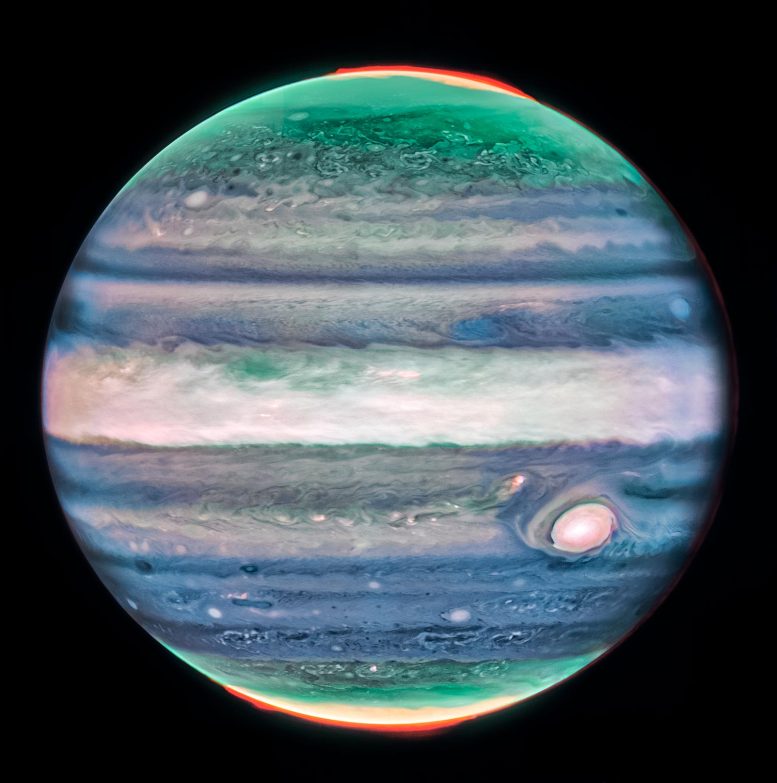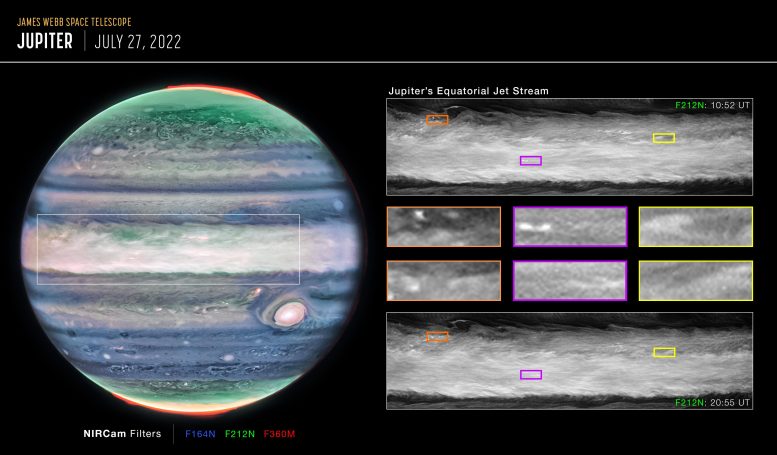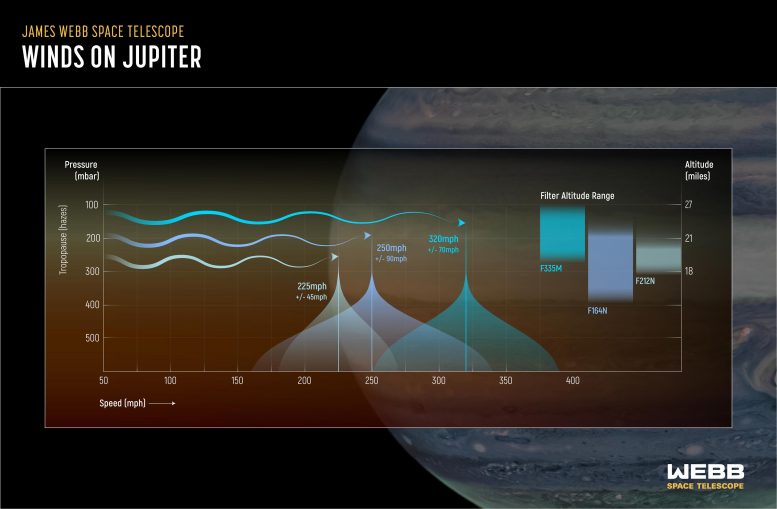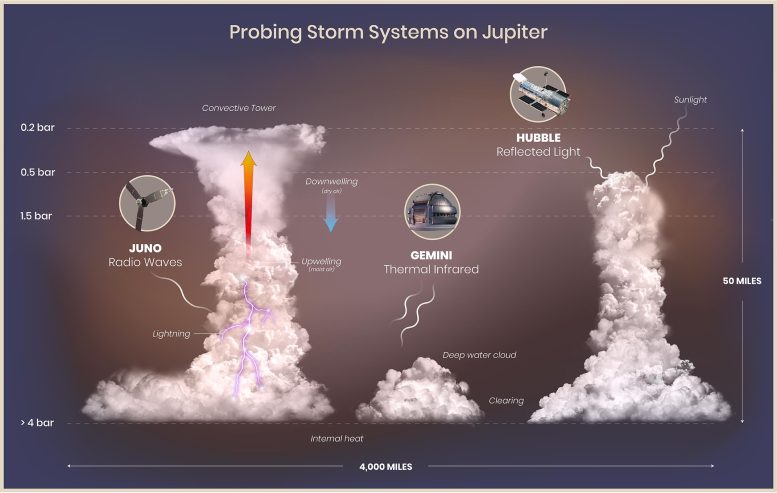
This image of Jupiter from NASA’s James Webb Space Telescope’s NIRCam (Near-Infrared Camera) shows stunning details of the majestic planet in infrared light. In this image, brightness indicates high altitude. The numerous bright white “spots” and “streaks” are likely very high-altitude cloud tops of condensed convective storms. Auroras, appearing in red in this image, extend to higher altitudes above both the northern and southern poles of the planet. By contrast, dark ribbons north of the equatorial region have little cloud cover. Credit: NASA, ESA, CSA, STScI, Ricardo Hueso (UPV), Imke de Pater (UC Berkeley), Thierry Fouchet (Observatory of Paris), Leigh Fletcher (University of Leicester), Michael H. Wong (UC Berkeley), Joseph DePasquale (STScI)
Narrow jet stream near Jupiter’s equator has winds traveling 320 miles per hour.
Jupiter has some of the most conspicuous atmospheric features in our solar system. The planet’s Great Red Spot, large enough to envelop Earth, is nearly as well known as some of the various rivers and mountains on the planet we call home.
However, much like Earth, Jupiter is ever-changing, and there’s much about the planet we have yet to learn. NASA’s James Webb Space Telescope is unlocking some of those mysteries, revealing new features of Jupiter we’ve never seen before, including a high-speed jet speeding over the planet’s equator. While the jet stream is not as visually apparent or stunning as some of Jupiter’s other features, it’s giving researchers incredible insight into how the layers of the planet’s atmosphere interact with each other, and how Webb will aid in these investigations in the future.

Researchers using NASA’s James Webb Space Telescope’s NIRCam (Near-Infrared Camera) have discovered a high-speed jet stream sitting over Jupiter’s equator, above the main cloud decks. At a wavelength of 2.12 microns, which observes between altitudes of about 12-21 miles (20-35 kilometers) above Jupiter’s cloud tops, researchers spotted several wind shears, or areas where wind speeds change with height or with distance, which enabled them to track the jet. This image highlights several of the features around Jupiter’s equatorial zone that, between one rotation of the planet (10 hours), are very clearly disturbed by the motion of the jet stream. Credit: NASA, ESA, CSA, STScI, Ricardo Hueso (UPV), Imke de Pater (UC Berkeley), Thierry Fouchet (Observatory of Paris), Leigh Fletcher (University of Leicester), Michael H. Wong (UC Berkeley), Joseph DePasquale (STScI)
Webb Space Telescope Discovers New Feature in Jupiter’s Atmosphere
NASA’s James Webb Space Telescope has discovered a new, never-before-seen feature in Jupiter’s atmosphere. The high-speed jet stream, which spans more than 3,000 miles (4,800 kilometers) wide, sits over Jupiter’s equator above the main cloud decks. The discovery of this jet is giving insights into how the layers of Jupiter’s famously turbulent atmosphere interact with each other, and how Webb is uniquely capable of tracking those features.
“This is something that totally surprised us,” said Ricardo Hueso of the University of the Basque Country in Bilbao, Spain, lead author on the paper describing the findings. “What we have always seen as blurred hazes in Jupiter’s atmosphere now appear as crisp features that we can track along with the planet’s fast rotation.”
Webb’s Unique Imaging Capabilities
The research team analyzed data from Webb’s NIRCam (Near-Infrared Camera) captured in July 2022. The Early Release Science program – jointly led by Imke de Pater from the University of California, Berkeley and Thierry Fouchet from the Observatory of Paris – was designed to take images of Jupiter 10 hours apart, or one Jupiter day, in four different filters, each uniquely able to detect changes in small features at different altitudes of Jupiter’s atmosphere.

Jupiter has a layered atmosphere, and this illustration displays how Webb is uniquely capable of collecting information from higher layers of the atmosphere than before. Scientists were able to use Webb to identify wind speeds at different layers of Jupiter’s atmosphere in order to isolate the high-speed jet. The observations of Jupiter were taken 10 hours apart, or one Jupiter day, in three different filters, noted here, each uniquely able to detect changes in small features at different altitudes of Jupiter’s atmosphere. Credit: NASA, ESA, CSA, STScI, Ricardo Hueso (UPV), Imke de Pater (UC Berkeley), Thierry Fouchet (Observatory of Paris), Leigh Fletcher (University of Leicester), Michael H. Wong (UC Berkeley), Andi James (STScI)
“Even though various ground-based telescopes, spacecraft like NASA’s Juno and Cassini, and NASA’s Hubble Space Telescope have observed the Jovian system’s changing weather patterns, Webb has already provided new findings on Jupiter’s rings, satellites, and its atmosphere,” de Pater noted.
Contrasting Atmospheric Layers
While Jupiter is different from Earth in many ways – Jupiter is a gas giant, Earth is a rocky, temperate world – both planets have layered atmospheres. Infrared, visible, radio, and ultraviolet-light wavelengths observed by these other missions detect the lower, deeper layers of the planet’s atmosphere – where gigantic storms and ammonia ice clouds reside.
On the other hand, Webb’s look farther into the near-infrared than before is sensitive to the higher-altitude layers of the atmosphere, around 15-30 miles (25-50 kilometers) above Jupiter’s cloud tops. In near-infrared imaging, high-altitude hazes typically appear blurry, with enhanced brightness over the equatorial region. With Webb, finer details are resolved within the bright, hazy band.

This illustration of lightning, convective towers (thunderheads), deep water clouds, and clearings in Jupiter’s atmosphere is based on data collected by the Juno spacecraft, the Hubble Space Telescope, and the Gemini Observatory. Juno detects radio signals generated by lightning discharges. Because radio waves can pass through all of Jupiter’s cloud layers, Juno is able to detect lightning in deep clouds as well as lightning on the day side of the planet. Hubble detects sunlight that has reflected off clouds in Jupiter’s atmosphere. Different wavelengths penetrate to different depths in the clouds, giving researchers the ability to determine the relative heights of cloud tops. Gemini maps the thickness of cool clouds that block thermal infrared light from warmer atmospheric layers below the clouds. Thick clouds appear dark in the infrared maps, while clearings appear bright. The combination of observations can be used to map the cloud structure in three dimensions and infer details of atmospheric circulation. Thick, towering clouds form where moist air rises (upwelling and active convection). Clearings form where drier air sinks (downwelling). The clouds shown rise five times higher than similar convective towers in Earth’s relatively shallow atmosphere. The region illustrated covers a horizontal span one-third greater than that of the continental United States. Credit: NASA, ESA, M.H. Wong (UC Berkeley), and A. James and M.W. Carruthers (STScI)
Properties of the New Jet Stream
The newly discovered jet stream travels at about 320 miles per hour (515 kilometers per hour), twice the sustained winds of a Category 5 hurricane here on Earth. It is located around 25 miles (40 kilometers) above the clouds, in Jupiter’s lower stratosphere (see graphic above).
By comparing the winds observed by Webb at high altitudes, to the winds observed at deeper layers from Hubble, the team could measure how fast the winds change with altitude and generate wind shears.
While Webb’s exquisite resolution and wavelength coverage allowed for the detection of small cloud features used to track the jet, the complementary observations from Hubble taken one day after the Webb observations were also crucial to determine the base state of Jupiter’s equatorial atmosphere and observe the development of convective storms in Jupiter’s equator not connected to the jet.
“We knew the different wavelengths of Webb and Hubble would reveal the three-dimensional structure of storm clouds, but we were also able to use the timing of the data to see how rapidly storms develop,” added team member Michael Wong of the University of California, Berkeley, who led the associated Hubble observations.
Future Observations and Implications
The researchers are looking forward to additional observations of Jupiter with Webb to determine if the jet’s speed and altitude change over time.
“Jupiter has a complicated but repeatable pattern of winds and temperatures in its equatorial stratosphere, high above the winds in the clouds and hazes measured at these wavelengths,” explained team member Leigh Fletcher of the University of Leicester in the United Kingdom. “If the strength of this new jet is connected to this oscillating stratospheric pattern, we might expect the jet to vary considerably over the next 2 to 4 years – it’ll be really exciting to test this theory in the years to come.”
“It’s amazing to me that, after years of tracking Jupiter’s clouds and winds from numerous observatories, we still have more to learn about Jupiter, and features like this jet can remain hidden from view until these new NIRCam images were taken in 2022,” continued Fletcher.
The researchers’ results were recently published in Nature Astronomy.
For more on this discovery:
Reference: “An intense narrow equatorial jet in Jupiter’s lower stratosphere observed by JWST” by Ricardo Hueso, Agustín Sánchez-Lavega, Thierry Fouchet, Imke de Pater, Arrate Antuñano, Leigh N. Fletcher, Michael H. Wong, Pablo Rodríguez-Ovalle, Lawrence A. Sromovsky, Patrick M. Fry, Glenn S. Orton, Sandrine Guerlet, Patrick G. J. Irwin, Emmanuel Lellouch, Jake Harkett, Katherine de Kleer, Henrik Melin, Vincent Hue, Amy A. Simon, Statia Luszcz-Cook and Kunio M. Sayanagi, 19 October 2023, Nature Astronomy.
DOI: 10.1038/s41550-023-02099-2
The James Webb Space Telescope is the world’s premier space science observatory. Webb is solving mysteries in our solar system, looking beyond to distant worlds around other stars, and probing the mysterious structures and origins of our universe and our place in it. Webb is an international program led by NASA with its partners, ESA (European Space Agency) and the Canadian Space Agency.









Be the first to comment on "Webb Space Telescope Reveals New Feature in Jupiter’s Atmosphere – “Totally Surprised Us”"